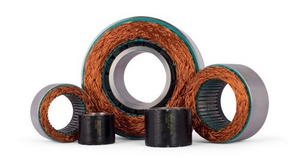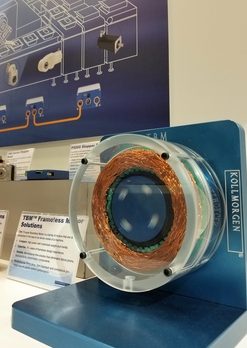 Frameless, or "servo motor kits”, open up numerous possibilities in designing motion elements for your machine related to performance. A frameless motor consists of rotor and stator components which are built into a machine assembly to transmit torque to a load. Many applications which take advantage of a frameless motor are direct driven, which eliminates bandwidth robbing compliance. Effectively, this means you have eliminated torsional losses and any wind-up or spring losses. Eliminating mechanical compliance can increase bandwidth capabilities by factor of 5, 10 or even 20 times. Increased bandwidth allows your machine to respond faster, improving productivity. Quicker move and settle means more indexes, which translates into more "widgets” per minute – increasing productivity.
Frameless, or "servo motor kits”, open up numerous possibilities in designing motion elements for your machine related to performance. A frameless motor consists of rotor and stator components which are built into a machine assembly to transmit torque to a load. Many applications which take advantage of a frameless motor are direct driven, which eliminates bandwidth robbing compliance. Effectively, this means you have eliminated torsional losses and any wind-up or spring losses. Eliminating mechanical compliance can increase bandwidth capabilities by factor of 5, 10 or even 20 times. Increased bandwidth allows your machine to respond faster, improving productivity. Quicker move and settle means more indexes, which translates into more "widgets” per minute – increasing productivity.
Frameless motors can also be designed to provide excellent torque density. This allows for a compact footprint, reducing both space and weight. In applications where space and weight are of paramount importance, frameless motors are a great solution. In addition, since there is less weight, there are potential energy savings as well. Common applications that use frameless motors include robots and robotic joints, weapon stations, sensor gimbals, sight systems, UAV propulsion and guidance, factory automation equipment and many more.
As I mentioned above, most applications considered for an embedded motor design are direct drive – meaning the motor is connected directly to the load, eliminating couplings, belts and pulleys, gearing, and other mechanical components. This inherently will significantly reduce necessary maintenance and improves uptime.
 Performance factors are not the only reason why frameless motors can be an ideal choice in an application. Choosing a frameless design does not mean you have to change the dynamics of how you build your machine. The rotor and stator components of the frameless motor don’t require any special tolerancing for your mechanism – you can follow your normal design flow and utilize these components as you would any other similar element. Total Indicator Runout (TIR) of the rotating shaft is typically more forgiving with regards to the rotor than what is typically required of the shaft itself. The stator portion is stationary and fixed in a housing. There are several methods to assemble both components in place, and it doesn’t involve shrink fitting, which can be a hassle. Most applications can utilize adhesive bonding to secure the elements in place. Advances in adhesives makes this much easier to accomplish. Clamping is an alternate method to secure the components as well.
Performance factors are not the only reason why frameless motors can be an ideal choice in an application. Choosing a frameless design does not mean you have to change the dynamics of how you build your machine. The rotor and stator components of the frameless motor don’t require any special tolerancing for your mechanism – you can follow your normal design flow and utilize these components as you would any other similar element. Total Indicator Runout (TIR) of the rotating shaft is typically more forgiving with regards to the rotor than what is typically required of the shaft itself. The stator portion is stationary and fixed in a housing. There are several methods to assemble both components in place, and it doesn’t involve shrink fitting, which can be a hassle. Most applications can utilize adhesive bonding to secure the elements in place. Advances in adhesives makes this much easier to accomplish. Clamping is an alternate method to secure the components as well.
A frameless motor consists of rotor and stator components that are integrated directly into the machine. There are many benefits to using a frameless motor including eliminating components, reducing torsional losses, decreasing weight/footprint and increasing machine response time. Frameless motors are much easier to incorporate into your design then you may have realized. Ready to go frameless and need some help? Stop by our Frameless Technology page or Contact us here.
About the Author
 Melanie Cavalieri is the Director of Product Marketing for Motors at Kollmorgen located in Radford, VA. She is a 2008 Mechanical Engineering graduate of Purdue University and has spent time in the printing, medical, sensing and motion control industries. Melanie has focused on market research, marketing strategy and product development since 2012.
Melanie Cavalieri is the Director of Product Marketing for Motors at Kollmorgen located in Radford, VA. She is a 2008 Mechanical Engineering graduate of Purdue University and has spent time in the printing, medical, sensing and motion control industries. Melanie has focused on market research, marketing strategy and product development since 2012.